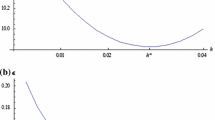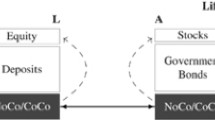Abstract
When an American warrant or a convertible bond is called by its issuer, the holder is usually given a notice period to decide whether to sell the derivative back to the issuer at the call price or to exercise the conversion right. Several earlier papers have shown that such notice period requirement may substantially affect the optimal call policy adopted by the issuer. In this paper, we perform theoretical studies on the impact of the notice period requirement on issuer’s optimal call policy for American warrants and convertible bonds. We also examine how the optimal call policy of the issuer interacts with holder’s optimal conversion policy.
Similar content being viewed by others
References
Altintig, Z. A., & Butler, A. (2005). Are they still late? The effect of notice period on calls of convertible bonds. Journal of Corporate Finance, 11, 337–350.
Ayache, E., Forsyth, P. A., & Vetzal, K. R. (2003). Valuation of convertible bonds with credit risk. Journal of Derivatives, 11(1), 9–29.
Asquith, P. (1995). Convertible bonds are not called late. Journal of Finance, 50(4), 1275–1289.
Brennan, M. J., & Schwartz, E. S. (1977). Convertible bonds: valuation and optimal strategies for call and conversion. Journal of Finance, 32, 1699–1715.
Bühler, W., & Koziol, C. (2003). Calling convertible bonds too late can be rational. Working paper of University of Mannheim.
Butler, A. W. (2002). Revisiting optimal call policy for convertible. Financial Analysts Journal, 58(1), 50–55.
Grau, A. J., Forsyth, P. A., & Vetzal, K. R. (2003). Convertible bonds with call notice periods. Working paper of the University of Waterloo.
Ingersoll, J. E. (1977a). A contingent claims valuation of convertible securities. Journal of Financial Economics, 4, 289–322.
Ingersoll, J. E. (1977b). An examination of corporate call policies on convertible securities. Journal of Finance, 32, 463–478.
Jaffee, D., & Shleifer, A. (1990). Costs of financial distress, delayed calls of convertible bonds, and the role of investment banks. Journal of Business, 63, 107–123.
Kwok, Y. K., & Wu, L. (2000). Effects of callable feature on early exercise feature. Review of Derivatives Research, 4, 189–211.
Kwok, Y. K. (2007). Mathematical models of financial derivatives (2nd ed.). Berlin: Springer.
Lau, K. W., & Kwok, Y. K. (2004). Anatomy of option features in convertible bonds. Journal of Futures Markets, 24, 513–532.
Yigitbasioglu, A. B., & Alexander, C. (2005) Pricing and hedging convertible bonds: delayed calls and uncertain volatility. Working paper of University of Reading.
Acknowledgement
This research was supported by the Research Grants Council of Hong Kong, HKUST6166/02H.
Author information
Authors and Affiliations
Corresponding author
Appendices
Appendix A – Proof of Proposition 1
-
1.
When q = 0, the callable American warrant is never exercised prematurely so that \({W(S, \tau)\leq c(S, \tau)}\), where c(S, τ) is the price function of the European call counterpart. For \({\tau \leq \tau_n}\), we have \({c_n(S, \tau_n) > c(S, \tau)\geq W(S, \tau)}\) so that the issuer never calls the warrant prematurely.
-
2.
To show that \({S^{\ast}_{\rm call}(\tau)}\) always exists for τ > τ n , we prove by contradiction. Assume that there exists some τ0 > τ n such that \({W(S, \tau) < c_n(S, \tau_n)}\) for all S and \({\tau_n < \tau \leq \tau_0}\), that is, the warrant is never called. Combining with the result in part (1), the callable American warrant then becomes a European call option for \({\tau \leq \tau_0}\) so that
$$ W(S, \tau) = c(S, \tau; X)\quad \hbox{for}\quad \tau \leq \tau_0. $$It suffices to show that W(S, τ) > c n (S, τ n ) for some S and \({\tau_n < \tau\leq \tau_0}\). For \({\tau_n < \tau\leq \tau_0}\), the put-call parity relation gives
$$ \eqalign{ c_n(S, \tau_n)-W(S, \tau)\cr=\hskip.3pc c_n(S, \tau_n)-c(S, \tau)\cr=\hskip.3pc Ke^{-r\tau_n}+c(S, \tau_n; K+X)-c(S, \tau; X)\cr=\hskip.3pc X(e^{-r\tau}-e^{-r\tau_n})+p(S, \tau_n; K+X)-p(S, \tau; X), }<!endaligned> $$where \({p(S, \tau; X)}\) denotes the price function of a European put with strike␣price X. Since the put price function tends to zero as S tends to infinity, p(S, τ; X) and p(S, τ n ; K + X) become sufficiently small when S is sufficiently large. Since we have
$$ \lim_{S\to \infty}[c_n(S, \tau_n)-W(S, \tau)]=X(e^{-r\tau}-e^{-r\tau_n}) < 0\quad \hbox{for}\quad \tau > \tau_n, $$we then deduce that there exist some sufficiently large value of S such that
$$ W(S, \tau) > c_n(S, \tau_n)\quad \hbox{for}\quad \tau_n < \tau\leq \tau_0. $$A contradiction is encountered since we have assumed \({W(S, \tau) < c_n(S, \tau_n)}\) for all S and \({\tau_n < \tau\leq \tau_0}\). This would imply that there exists critical stock price \({S^{\ast}_{\rm call}}\) such that when S reaches the level \({S^{\ast}_{\rm call}, W(S, \tau)}\) becomes equal to \({c_n(S,\tau_n)}\).
-
3.
The monotonically decreasing property of \({S^{\ast}_{\rm call}(\tau)}\) is derived from the monotonically increasing property of the price function W(S, τ) with respect to τ. To show the unboundedness of \({S^{\ast}_{\rm call}(\tau^+_n)}\), we prove by contradiction. Suppose \({S^{\ast}_{\rm call}(\tau^+_n)}\) is finite, by continuity of the price function, we have
$$ W(S,\tau_n)=c_n(S, \tau_n)\quad \hbox{for}\quad S > S^{\ast}_{\rm call}(\tau^+_n). $$This leads to a contradiction since the issuer should not call the warrant at τ = τ n . Hence, \({S^{\ast}_{\rm call}\to \infty}\) as \({\tau \to \tau^+_n}\). By setting q = 0 in the asymptotic formula for \({S^{\ast}_{\rm call}(\infty)}\) in Proposition 2 [see Eq. (16)] and observing that μ+ = 1 when q = 0, we obtain Eq. (9).
Appendix B – Proof of Proposition 2
The proofs of the existence of \({S^{\ast}_{\rm call}(\tau)}\) for all τ and the decreasing property of \({S^{\ast}_{\rm call}(\tau)}\) can be established using similar arguments as presented in Appendix A.
We compute the asymptotic limit \({S^{\ast}_{\rm call}(\infty)}\) by solving the price function W ∞(S) of the perpetual callable American warrant. The governing equation of W ∞(S) is given by
with boundary conditions
and smooth pasting condition
where
The general solution to the price function W ∞(S) takes the form (Kwok, 2007)
where α is an arbitrary constant and μ+ is the positive root of the auxiliary equation:
The arbitrary constant α and \({S^{\ast}_{\rm call}(\infty)}\) are determined by solving simultaneously
By eliminating α and using the price formula of \({c_n(S, \tau_n)}\) in Eq. (8), the asymptotic lower bound \({S^{\ast}_{\rm call}(\infty)}\) is determined by solving
where
By setting q = 0, the above equation for \({S^{\ast}_{\rm call}(\infty)}\) reduces to Eq. (9).
Appendix C – Proof of Proposition 3
-
1.
Suppose we let \({\widetilde{W}(S, \tau)=B(S, \tau)-X}\), where B(S, τ) is the price of a non-callable convertible bond. Without the embedded callable right in the bond, we always have \({{\cal L}B\geq 0}\). It then follows that \({\widetilde{W}(S, \tau)}\) satisfies the following linear complementarity formulation
$$ \eqalign{ {\cal L}\widetilde{W}\geq -rX\quad \hbox{and}\quad \widetilde{W}\geq S-X\cr ({\cal L}\widetilde{W}+rX)[\widetilde{W}-(S-X)]=0 }<!endaligned> $$and
$$ \widetilde{W}(S, 0) =(S-X)^+. $$The above formulation differs from that of an American call only by the source term −rX. By using the comparison principle, we deduce that \({\widetilde{W}(S, \tau)\leq C(S, \tau)}\), where C(S,τ) is the price function of the American call. The price curve of \({\widetilde{W}(S, \tau)}\) always stays below that of C(S, τ) so that it intersects the intrinsic value line S − X at a lower critical stock price, hence \({S^{\ast}_b(\tau)\leq S^{\ast}(\tau)}\) for all \({\tau \geq 0}\).
-
2.
It is obvious that \({S^{\ast}_b(\tau)\geq Xe^{-r\tau}}\) since the lower bound of the bond value is given by max(Xe −rτ, S). As τ → 0+, we have
$$ S^{\ast}_b(0^+)\geq X. $$(i)On the other hand, suppose \({S^{\ast}_b(0^+) > X}\), then there exists some stock price level S satisfying \({X < S < S^{\ast}_b(0^+)}\) such that the bond remains alive at τ→ 0+. By continuity, the bond value is equal to S as τ→ 0+. Substituting B(S,␣0+) = S into the Black-Scholes equation, we have \({\frac{\partial B}{\partial \tau}(S, 0^+)= -qS < 0}\). A contradiction is encountered since this implies that the bond value falls below the intrinsic value. Hence, we deduce that
$$ S^{\ast}_b(0^+)\leq X. $$(ii)Combining the above two inequalities, we obtain \({S^{\ast}_b(0^+)=X}\). When τ → ∞, the convertible bond becomes essentially equivalent to the American warrant with zero strike price. Recall that \({S^{\ast}(\infty)=\frac{\mu_+}{\mu_+-1}X}\), so we obtain \({S^{\ast}_b(\infty)=0}\) since X is taken to be 0.
Rights and permissions
About this article
Cite this article
Dai, M., Kwok, Y.K. Optimal policies of call with notice period requirement. Asia-Pacific Finan Markets 12, 353–373 (2005). https://doi.org/10.1007/s10690-006-9030-9
Published:
Issue Date:
DOI: https://doi.org/10.1007/s10690-006-9030-9




